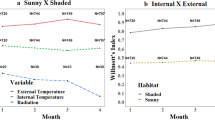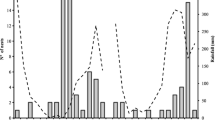Abstract
The Asian weaver ant Oecophylla smaragdina is of importance to Southeast Asian livelihoods as a source of human food and animal feed and as biological control agent in tree crops including mango and citrus. The introduction of weaver ants in plantations requires the inclusion of the reproductive queen. We report on locating the gravid queen in a mature O. smaragdina colony in Laos. The queen tree could be identified by considering tree height and number of nests in the tree: no tree was taller and housed more nests than the queen tree. The queen nest was a small nest, located near the tree top and near the trunk, and with more workers patrolling its exterior than at other small nests in the queen tree. The queen nest can be highly inconspicuous in dense tree crowns. Queen nest identification was ascertained by tapping and shaking nests, supporting branches, or entire trees, which elicits queen evacuation with retinue.

Similar content being viewed by others
References
Césard N (2004) Harvesting and commercialisation of kroto (Oecophylla smaragdina) in the Malingping area, West Java, Indonesia. In: Kusters K, Belcher B (eds) Forest products, livelihoods and conservation. Case studies of non-timber product systems. Center for International Forestry Research, Jakarta, pp 61–77
Crozier RH, Newey PS, Schlüns EA, Robson SKA (2009) A masterpiece of evolution—Oecophylla weaver ants (Hymenoptera: Formicidae). Myrmecol News 13:57–71
Del Toro I, Ribbons RR, Pelini SL (2012) The little things that run the world revisited: a review of ant-mediated ecosystem services and disservices (Hymenoptera: Formicidae). Myrmecol News 17:133–146
Djieto-Lordon C, Dejean A (1999) Tropical arboreal ant mosaics: innate attraction and imprinting determine nest site selection in dominant ants. Behav Ecol Sociobiol 45:219–225
Franks NR, Sendova-Franks AB (1999) Queen transport during ant colony emigration: a group-level adaptive behaviour. Behav Ecol 11:315–318
Nonaka K, Boulidam S, Yanahara N (2008) Edible insects as eco-cultural resources in Lao PDR. Paper presented at 31st International Geographical Union congress, Tunis, Tunisia, 12–15 Aug 2008
Offenberg J, Wiwatwitaya D (2010) Sustainable weaver ant (Oecophylla smaragdina) farming: harvest yields and effects on worker ant density. Asian Myrmecol 3:55–62
Offenberg J, Cuc NTT, Wiwatwitaya D (2013) The effectiveness of weaver ant (Oecophylla smaragdina) biocontrol in Southeast Asian citrus and mango. Asian Myrmecol 5:139–149
Peng RK, Christian K, Gibb K (1998a) How many queens are there in mature colonies of the green ant, Oecophylla smaragdina (Fabricius)? Aust J Entomol 37:249–253
Peng RK, Christian K, Gibb K (1998b) Locating queen ant nests in the green ant, Oecophylla smaragdina (Hymenoptera, Formicidae). Insect Soc 45:477–480
Peng R, Christian K, Gibb K (2012) The best time of day to monitor and manipulate weaver ant colonies in biological control. J Appl Entomol 136:155–160
Peng RK, Nielsen MG, Offenberg J, Birkmose D (2013) Utilisation of multiple queens and pupae transplantation to boost early colony growth of weaver ants Oecophylla smaragdina. Asian Myrmecol 5:177–184
Rwegasira RG, Mwatawala M, Rwegasira GM, Mogens GN, Offenberg J (2015) Comparing different methods for trapping mated queens of weaver ants (Oecophylla longinoda Latreille) (Hymenoptera: Formicidae). Biocontrol Sci Technol 25:503–512
Schlüns EA, Wegener BJ, Schlüns H, Azuma N, Robson SKA, Crozier RH (2009) Breeding system, colony and population structure in the weaver ant Oecophylla smaragdina. Mol Ecol 18:156–167
Sribandit W, Wiwatwitaya D, Suksard S, Offenberg J (2008) The importance of weaver ant (Oecophylla smaragdina Fabricius) harvest to a local community in Northeastern Thailand. Asian Myrmecol 2:129–138
Van Itterbeeck J, Sivongxay N, Praxaysombath B, van Huis A (2014) Indigenous knowledge of the edible weaver ant Oecophylla smaragdina Fabricius Hymenoptera: Formicidae from the Vientiane Plain, Lao PDR. Ethnobiol Lett 5:4–12
Van Itterbeeck J, Sivongxay N, Praxaysombath B, van Huis A (2015) Preliminary observations on gravid queen protection in Oecophylla smaragdina: evacuation and retinue function. Asian Myrmecol (in press)
Van Mele P (2008) A historical review of research on the weaver ant Oecophylla in biological control. Agric For Entomol 10:13–22
Van Mele P, Cuc NTT (2000) Evolution and status of Oecophylla smaragdina (Fabricius) as a pest control agent in citrus in the Mekong Delta, Vietnam. Int J Pest Manage 46:295–301
Van Mele P, Cuc NTT (2007) Ants as friends: improving your tree crops with weaver ants. Africa Rice Center, Cotonou and CABI, Egham
Acknowledgments
This study was conducted under an Agreement between the Department of Plant Sciences, Wageningen University, and the Faculty of Science, National University of Laos. Dr. Decha Wiwatwitaya, Kasetsart University, Thailand is thanked for identifying the ant species. Mr Vilakorn “Xang” Sanevongsiya is thanked for his excellent assistance in the field and laboratory. The anonymous reviewers and the editors are kindly thanked for their constructive comments which improved the manuscript.
Conflict of interest
There is no conflict of interest.
Author information
Authors and Affiliations
Corresponding author
Rights and permissions
About this article
Cite this article
Van Itterbeeck, J., Sivongxay, N., Praxaysombath, B. et al. Location and external characteristics of the Oecophylla smaragdina queen nest. Insect. Soc. 62, 351–356 (2015). https://doi.org/10.1007/s00040-015-0411-9
Received:
Revised:
Accepted:
Published:
Issue Date:
DOI: https://doi.org/10.1007/s00040-015-0411-9




